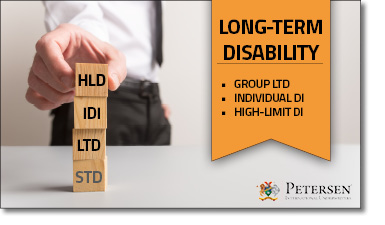Advanced Income Replacement Strategies

Comprehensive disability insurance isn’t usually the first product on the minds of U.S. insurance advisors, nor is it on the minds of their clients. The average American rarely inquires about most aspects of insurance, but when they do, it usually entails coverage types more requisite to government mandates, like medical or auto insurance, or preconceived notions of coverage for definite eventualities, like life insurance. We are now required to have health and auto insurance, and we all know that someday we will die, but most of us never think we will be so sick or injured that we can’t work and earn a living.
Americans, regardless of age or gender have a generalized “Superman” complex, not believing they are susceptible to accident or illness and eventual temporary or permanent disablement. But the statistical data relays a vivid picture much to the contrary. According to the Council for Disability Awareness, more than one in four 20-year-olds can expect to be out of work for at least a year due to disablement before they reach retirement age. And 5.6 percent of working Americans suffer a short-term disability every year. In spite of this alarming information, 51 million working adults in this country are living without some form of disability insurance other than miniscule Social Security benefits. Furthermore, most U.S. households lack adequate savings, liquid assets or balanced retirement vehicles in case of long-term disablement. Only 48 percent of adults report that they have saved enough to cover three months of living expenses if they encountered a stoppage of income.
Income is our greatest asset. Without a steady inflow of personal capital, we as Americans cannot expect to flourish let alone maintain a life of avid consumerism in a country where we must pay to survive. Food, shelter, clothing, healthcare, schooling, transportation, insurance, entertainment – it all costs money. Without an income, the dominoes fall and life turns to chaos and eventually, financial ruin for your clients and their dependent families.
In consideration of all of this, it becomes most apparent that adequate disability insurance for income replacement should be the cornerstone of any sound financial plan for every working American. Disability insurance is fundamental and must be prescribed in sufficient amounts as often as life or medical insurance. And you, the broker and trusted advisor must promote it, sell it, because DI doesn’t sell itself. But how much DI is sufficient? Financial experts agree that 65 percent of monthly income replacement is the absolute minimum level needed to maintain some semblance of one’s pre-disability lifestyle in case of total disablement.

But a single disability income policy is not going cut it. You would be hard pressed to provide your clients with enough protection from one disability policy because insurance companies want it that way. Carriers regularly practice reverse discrimination when it comes to income protection. The more income you earn, the lower the percentage level of income protection is allowed by insurance companies. Their methods of shunning risk accumulation keep higher income earners from being sufficiently insured. Traditional DI companies view higher benefits as compelling incentives for insured persons to unnecessarily and prematurely go out on claim. High-limit disability benefits make most carriers uneasy. However, the industry has solutions to this egregious problem through a tiered approach of layering multiple, comprehensive disability plans through different carriers from different sectors of the market, one on top of another to achieve a desired income replacement level.
Many working professionals are provided employer-sponsored or employer-paid, guaranteed-issue, group long-term disability benefits which usually have modest benefit caps that provide employees with common benefit levels up to 40 percent to 60 percent of income. Group benefits like that, on a fiduciary level, prove to be mostly sufficient for many working Americans. But the usual policy caps of $7,500 to $20,000 per month hardly allow for enough protection for higher income earners which is where we regularly witness the discrimination.
The next option is a layer of individual, fully-underwritten disability insurance. IDI is the mainstay of the industry and is marketed by numerous life and health carriers. The available benefits and riders are robust and long-term in nature, but again, we find excessive limitations when considering high-net worth clientele. Those making in excess of $300,000 annually will still find it difficult to reach that 65 percent income replacement figure when dealing with only one or two traditional layers of disability insurance.
The ultimate tool in replacing one’s income is high-limit or excess disability coverage. The third tier of income indemnification can be found in the secondary or Surplus Lines market which harbors specialty carriers like Lloyd’s of London and their marketplace of high-limit DI experts where extraordinary earnings can be appropriately insured to levels of at least 65 percent of income replacement.
Another strategy of layering multiple policies for higher levels of disability benefits can be found among the recently expanded guaranteed-issue or GSI market offerings. GSI coverage is in the “spotlight” at the moment, and is being touted by both domestic and specialty-market carriers, commonly replacing IDI and high-limit excess layers. The GSI product lines are very attractive to consumers, employers, human resource managers as well as insurance professionals.
As the product name so suggests, these multi-life policies are guaranteed-issue, requiring no time consuming, physically intrusive exams, blood draws or urine samplings, allowing employees to sign-up electronically or with simple enrollment forms. The ease of enrollment is beneficial to all parties involved and gives employers the clout of providing added benefits, promoting employee contentment and retention. Furthermore, the price is certainly right to GSI program sponsors as the products usually call for substantial group or multi-life premium discounts.
In terms of marketing, GSI product platforms lend themselves nicely to coveted groups commonly targeted by brokers such as law firms, accounting agencies, hospitals, surgery centers and other large corporate entities. And much to the pleasure of the brokers landing this type of business, the commissions are significant, and the business tends to stay on the books for many years.
The GSI market continues to be very lucrative, and recently has become the focus of many in the business. However, a very important income replacement strategy that is often overlooked by many insurance agents deals with the use of personal DI benefits to address business risks. This is a serious conundrum that, unbeknownst to many, has plagued the disability insurance industry for many decades.

Business owners often face more responsibility and risk than their employees. In addition to protecting personal assets and their own livelihoods, owners are also tasked with maintaining business entities that they and their employees count on. The running and growth of those business entities naturally create a number of liabilities that require financial protection through disability insurance.
Unfortunately, it is a common occurrence for owners to assign their personal disability income benefits to indemnify business risk that can be better solved using ancillary DI products such as business overhead expense (BOE) coverage, buy/sell insurance, key person coverage or loan indemnification. The underuse of the latter is the most common folly.
The lending of capital by the Small Business Administration and other commercial and private financial institutions is a routine aspect of business development and company growth in the U.S. Most lenders require disability insurance policies as collateral to help indemnify risk to secure business loans. Because they are misinformed and/or striving to be frugal, borrowers frequently assign personal DI benefits or their existing BOE policies to secure needed loans. This creates the terrible problem that in time of disablement, the borrower would stand to lose important income replacement for the protection of their families or benefits specifically earmarked for business continuation while they are out on disability.
The sacrifice of personal DI benefits to cover business risks or the sacrifice of BOE benefits to cover loan requirements should not be advised or tolerated. There are ample solutions in the market to address these scenarios. There are product lines designed to address these concerns such as business loan indemnification insurance as well as contract guarantee insurance. Both are available as separate resources to usual business disability insurances, and available benefits can be manipulated to cover specific contractual needs of business owners.
Income replacement through disability insurance gives back financial freedoms that are commonly stolen by disabling accidents and illnesses. The discussed advanced strategies will assist you in providing your clients with the most sincere protection of their greatest asset – their income.
-published with permission from Broker World Magazine